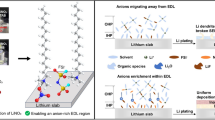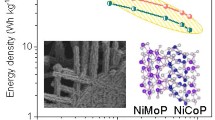Abstract
Antimony-based materials with high capacities and moderate potentials are promising anodes for lithium-/sodium-ion batteries. However, their tremendous volume expansion and inferior conductivity lead to poor structural stability and sluggish reaction kinetics. Herein, a double-confined nanoheterostructure Sb/Sb2S3@Ti3C2Tx@C has been fabricated through a solvothermal method followed by low-temperature heat treatment. The dual protection of “MXene” and “carbon” can better accommodate the volume expansion of Sb/Sb2S3. The strong covalent bond (Ti–S, Ti–O–Sb, C–O–Sb) can firmly integrate Sb-based material with Ti3C2Tx and carbon, which significantly improves the structure stability. In addition, the carbon layer can restrain the oxidation of MXenes, and the nano-Sb/Sb2S3 can facilitate electron/ion transport and suppress the restacking of MXenes. The heterogeneous interface between Sb and Sb2S3 can further promote interfacial charge transfer. The MXene-Sb/Sb2S3@C-1 with the optimal Sb content shows high specific capacities, comparable rate properties and ultra-stable cycling performances (250 mAh·g−1 after 2500 cycles at 1 A·g−1 for sodium-ion batteries). Ex situ X-ray diffractometer (XRD) test reveals the storage mechanism including the conversion and alloying process of MXene-Sb/Sb2S3@C-1. Cyclic voltammetry (CV) test results demonstrate that the pseudocapacitance behavior is dominant in MXene-Sb/Sb2S3@C-1, especially at large current. This design paves the way for exploring high-performance alloy-based/conversion-type anode for energy storage devices.
Graphical abstract

摘要
高容量, 电位适中的锑基材料是极具发展前景的锂/钠离子电池负极材料。但由于其体积膨胀大、导电性差,导致结构稳定性差、反应动力学迟钝。本文采用溶剂热结合低温热处理法制备了双限域纳米异质结构Sb/Sb2S3@Ti3C2Tx@C。“MXene”和“碳”的双重保护可以更好地容纳Sb/Sb2S3的体积膨胀。强共价键(Ti–S, Ti–O–Sb, C–O–Sb)能将Sb基材料与Ti3C2Tx和碳紧密结合,显著提高了结构稳定性。此外,碳层可以抑制MXenes的氧化,纳米Sb/Sb2S3可以促进电子/离子的传递,抑制MXenes的重堆积。Sb与Sb2S3之间的非均相界面进一步促进了界面电荷的转移。具有最佳Sb含量的MXene-Sb/Sb2S3@C-1具有较高的比容量、优异的倍率性能和超稳定的循环性能(钠离子电池在1 A·g-1下循环2500次后可达到250 mAh·g−1)。非原位XRD测试揭示了MXene-Sb/Sb2S3@C-1的储能机理,包括转化和合金化过程。循环伏安测试结果表, MXene-Sb/Sb2S3@C-1的赝电容行为占主导地位,特别是在大电流条件下。本研究为开发高性能合金/转换型负极材料提供了一定的理论指导和技术支持。






Similar content being viewed by others
References
Delmas C. Sodium and sodium-ion batteries: 50 years of research. Adv Energy Mater. 2018;8(17):1703137. https://doi.org/10.1002/aenm.201703137.
Nayak PK, Yang L, Brehm W, Adelhelm P. From lithium-ion to sodium-ion batteries: advantages, challenges, and surprises. Angew Chem Int Ed Engl. 2018;57(1):102. https://doi.org/10.1002/anie.201703772.
Han JH, He J, Zou QY, Zhang J, Yang Z, Zhao ZW, Chen HX, Yue HJ, Wang DW, Lin HC, Liu HD, Zhong GM, Peng ZQ. High-capacity potassium ion storage mechanisms in a soft carbon revealed by solid-state NMR spectroscopy. Rare Met. 2022;41(11):3752. https://doi.org/10.1007/s12598-022-02063-5.
Song K, Liu C, Mi L, Chou S, Chen W, Shen C. Recent progress on the alloy-based anode for sodium-ion batteries and potassium-ion batteries. Small. 2021;17(9):1903194. https://doi.org/10.1002/smll.201903194.
Zhang W, Zhang F, Ming F, Alshareef HN. Sodium-ion battery anodes: status and future trends. EnergyChem. 2019;1(2):100012. https://doi.org/10.1016/j.enchem.2019.100012.
Fu Y, Wei Q, Zhang G, Sun S. Advanced phosphorus-based materials for lithium/sodium-ion batteries: recent developments and future perspectives. Adv Energy Mater. 2018;8(13):1703058. https://doi.org/10.1002/aenm.201702849.
Fu T, Li PC, He HC, Ding SS, Cai Y, Zhang M. Electrospinning with sulfur powder to prepare CNF@G-Fe9S10 nanofibers with controllable particles distribution for stable potassium-ion storage. Rare Met. 2022;42(1):111. https://doi.org/10.1007/s12598-022-02103-0.
Luo W, Ren J, Feng W, Chen X, Yan Y, Zahir N. Engineering nanostructured antimony-based anode materials for sodium ion batteries. Coatings. 2021;11(10):1233. https://doi.org/10.3390/coatings11101233.
Chong S, Qiao S, Wei X, Li T, Yuan L, Dong S, Huang W. Sb2S3-based conversion-alloying dual mechanism anode for potassium-ion batteries. iScience. 2021;24(12):103494. https://doi.org/10.1016/j.isci.2021.103494.
Yao S, Cui J, Deng Y, Chong WG, Wu J, Ihsan-Ul-Haq M, Mai YW, Kim JK. Ultrathin Sb2S3 nanosheet anodes for exceptional pseudocapacitive contribution to multi-battery charge storage. Energy Storage Mater. 2019;20:36. https://doi.org/10.1016/j.ensm.2018.11.005.
Li D, Zhao S, Li J, Yuan Z, Cao J, Fu X, Zhang Y, Wang L, Han W. Ultrafine Sb2S3@carbon-nanofibers for fast and stable sodium storage. Electrochim Acta. 2022;411(10):140067. https://doi.org/10.1016/j.electacta.2022.140067.
Xia J, Zhang X, Yang Y, Wang X, Yao J. Electrospinning fabrication of flexible, foldable, and twistable Sb2S3/TiO2/C nanofiber anode for lithium ion batteries. Chem Eng J. 2021;413(1):127400. https://doi.org/10.1016/j.cej.2020.127400.
Zhang Z, Zhao J, Xu M, Wang H, Gong Y, Xu J. Facile synthesis of Sb2S3/MoS2 heterostructure as anode material for sodium-ion batteries. Nanotechnology. 2018;29(33):335401. https://doi.org/10.1088/1361-6528/aac645.
Jia R, Li L, Shen G, Chen D. Hierarchical Sb2S3/SnS2/C heterostructure with improved performance for sodium-ion batteries. Sci China Mater. 2022;65(6):1443. https://doi.org/10.1007/s40843-021-1931-0.
Li X, Liang H, Liu X, Sun R, Qin Z, Fan H, Zhang Y. Ion-exchange strategy of CoS2/Sb2S3 hetero-structured nanocrystals encapsulated into 3D interpenetrating dual-carbon framework for high-performance Na+/K+ batteries. Chem Eng J. 2021;425(1):130657. https://doi.org/10.1016/j.cej.2021.130657.
Ke G, Wu X, Chen H, Li W, Fan S, Mi H, Li Y, Zhang Q, He C, Ren X. Unveiling the reaction mechanism of an Sb2S3–Co9S8/NC anode for high-performance lithium-ion batteries. Nanoscale. 2021;13(47):20041. https://doi.org/10.1039/d1nr06069d.
Dong S, Li C, Ge X, Li Z, Miao X, Yin L. ZnS-Sb2S3@C core-double shell polyhedron structure derived from metal-organic framework as anodes for high performance sodium ion batteries. ACS Nano. 2017;11(6):6474. https://doi.org/10.1021/acsnano.7b03321.
Li C, Song H, Mao C, Peng H, Li G. A novel MoS2 nanosheets-decorated Sb@Sb2S3@C tubular composites as anode material for high performance lithium ion battery. J Alloys Compd. 2019;786(25):169. https://doi.org/10.1016/j.jallcom.2019.01.315.
Wu Y, Zheng J, Tong Y, Liu X, Sun Y, Niu L, Li H. Carbon hollow tube-confined Sb/Sb2S3 nanorod fragments as highly stable anodes for potassium-ion batteries. ACS Appl Mater Interfaces. 2021;13(43):51066. https://doi.org/10.1021/acsami.1c16267.
Xu X, Zhang Y, Sun H, Zhou J, Yang F, Li H, Chen H, Chen Y, Liu Z, Qiu Z, Wang D, Ma L, Wang J, Zeng Q, Peng Z. Progress and perspective: MXene and MXene-based nanomaterials for high-performance energy storage devices. Adv Electron Mater. 2021;7(7):2000967. https://doi.org/10.1002/aelm.202000967.
VahidMohammadi A, Mojtabavi M, Caffrey NM, Wanunu M, Beidaghi M. Assembling 2D MXenes into highly stable pseudocapacitive electrodes with high power and energy densities. Adv Mater. 2019;31(8):1806931. https://doi.org/10.1002/adma.201806931.
Zhang H, Xiong D, Xu C, Xie Y, Zeng L, Feng Z, He M, Liu Q. VSe2/MXene composite with hierarchical three-dimensional structure encapsulated in dopamine as an anode for potassium-ion batteries. Electrochim Acta. 2022;421(20):140487. https://doi.org/10.1016/j.electacta.2022.140487.
Li P, Zang R, Wu Y, Liu S, Wang S, Liu P, Li P. A quasi-3D Sb2S3/reduced graphene oxide/MXene (Ti3C2Tx) hybrid for high-rate and durable sodium-ion batteries. Nanoscale. 2022;14(14):5529. https://doi.org/10.1039/d2nr00655c.
Wang T, Shen D, Liu H, Chen H, Liu Q, Lu B. A Sb2S3 nanoflower/MXene composite as an anode for potassium-ion batteries. ACS Appl Mater Interfaces. 2020;12(52):57907. https://doi.org/10.1021/acsami.0c18285.
Zhu M, Deng X, Feng Z, He M, Feng Y, Xiong D. Graphite nano-modified SnO2–Ti2C MXene as anode material for high-performance lithium-ion batteries. J Alloys Compd. 2021;886(15):161139. https://doi.org/10.1016/j.jallcom.2021.161139.
Ren M, Cao D, Jiang W, Su K, Pan L, Jiang Y, Yan S, Qiu T, Yang M, Yang J, Zhang C. Hierarchical composite of Sb2S3 decorated on highly crumpled Ti3C2Tx nanosheets for enhanced sodium storage properties. Electrochim Acta. 2021;373(20):137835. https://doi.org/10.1016/j.electacta.2021.137835.
Zhao J, Li CL, Chen G, Ji F, Shen YY, Peng J, Wang WH. Rational design of Sn4P3/Ti3C2Tx composite anode with enhanced performance for potassium-ion battery. Rare Met. 2022;41(7):2259. https://doi.org/10.1007/s12598-021-01934-7.
Wang H, Song X, Lv M, Jin S, Xu J, Kong X, Li X, Liu Z, Chang X, Sun W, Zheng J, Li X. Interfacial covalent bonding endowing Ti3C2–Sb2S3 composites high sodium storage performance. Small. 2022;18(3):2104293. https://doi.org/10.1002/smll.202104293.
Jing WT, Zhang Y, Gu Y, Zhu YF, Yang CC, Jiang Q. N-doped carbon nanonecklaces with encapsulated Sb as a sodium-ion battery anode. Matter. 2019;1(3):720. https://doi.org/10.1016/j.matt.2019.03.010.
Xie J, Liu L, Xia J, Zhang Y, Li M, Ouyang Y, Nie S, Wang X. Template-free synthesis of Sb2S3 hollow microspheres as anode materials for lithium-ion and sodium-ion batteries. Nanomicro Lett. 2018;10(1):12. https://doi.org/10.1007/s40820-017-0165-1.
Zhao N, Zhang F, Zhan F, Yi D, Yang Y, Cui W, Wang X. Fe3+-stabilized Ti3C2T MXene enables ultrastable Li-ion storage at low temperature. J Mater Sci Technol. 2021;67(20):156. https://doi.org/10.1016/j.jmst.2020.06.037.
Shen L, Zhao W, Wang K, Xu J. GO-Ti(3)C(2) two-dimensional heterojunction nanomaterial for anticorrosion enhancement of epoxy zinc-rich coatings. J Hazard Mater. 2021;417(5):126048. https://doi.org/10.1016/j.jhazmat.2021.126048.
Zhao R, Di H, Wang C, Hui X, Zhao D, Wang R, Zhang L, Yin L. Encapsulating ultrafine Sb nanoparticles in Na+ pre-intercalated 3D porous Ti3C2Tx MXene nanostructures for enhanced potassium storage performance. ACS Nano. 2020;14(10):13938. https://doi.org/10.1021/acsnano.0c06360.
Sarycheva A, Gogotsi Y. Raman spectroscopy analysis of the structure and surface chemistry of Ti3C2Tx MXene. Chem Mater. 2020;32(8):3480. https://doi.org/10.1021/acs.chemmater.0c00359.
Wang Z, Duan C, Wang D, Dong K, Luo S, Liu Y, Wang Q, Zhang Y, Hao A. BiSb@Bi2O3/SbOx encapsulated in porous carbon as anode materials for sodium/potassium-ion batteries with a high pseudocapacitive contribution. J Colloid Interface Sci. 2020;580(15):429. https://doi.org/10.1016/j.jcis.2020.07.061.
Yu J, Meng BC, Wang LJ, Wang Q, Huang WL, Wang XY, Fang Z. Depositing natural stibnite on 3D TiO2 nanotube array networks as high-performance thin-film anode for lithium-ion batteries. Rare Met. 2021;40(11):3215. https://doi.org/10.1007/s12598-020-01658-0.
Tang J, Huang X, Lin T, Qiu T, Huang H, Zhu X, Gu Q, Luo B, Wang L. MXene derived TiS2 nanosheets for high-rate and long-life sodium-ion capacitors. Energy Storage Mater. 2020;26:550. https://doi.org/10.1016/j.ensm.2019.11.028.
Zhou X, Zhong Y, Yang M, Hu M, Wei J, Zhou Z. Sb nanoparticles decorated N-rich carbon nanosheets as anode materials for sodium ion batteries with superior rate capability and long cycling stability. Chem Commun (Camb). 2014;50(85):12888. https://doi.org/10.1039/c4cc05989a.
Dashairya L, Das D, Saha P. Elucidating the role of graphene and porous carbon coating on nanostructured Sb2S3 for superior lithium and sodium storage. J Alloys Compd. 2021;883(25):160906. https://doi.org/10.1016/j.jallcom.2021.160906.
Acknowledgements
This study was financially supported by the National Natural Science Foundation of China (Nos. 52071073, 52177208, 52171202 and 51971055), Hebei Province “333 talent project” (No. C20221012), the Natural Science Foundation of Hebei Province (No. E2020501004), the Fundamental Research Funds for the Central Universities (No. N2123032) and the Science and Technology Project of Hebei Education Department (No. BJK2023005).
Author information
Authors and Affiliations
Corresponding author
Ethics declarations
Conflict of interests
The authors declare that they have no conflict of interest.
Supplementary Information
Below is the link to the electronic supplementary material.
Rights and permissions
Springer Nature or its licensor (e.g. a society or other partner) holds exclusive rights to this article under a publishing agreement with the author(s) or other rightsholder(s); author self-archiving of the accepted manuscript version of this article is solely governed by the terms of such publishing agreement and applicable law.
About this article
Cite this article
Wang, D., Ma, Q., He, H. et al. Double-confined nanoheterostructure Sb/Sb2S3@Ti3C2Tx@C toward ultra-stable Li-/Na-ion batteries. Rare Met. 43, 2067–2079 (2024). https://doi.org/10.1007/s12598-023-02550-3
Received:
Revised:
Accepted:
Published:
Issue Date:
DOI: https://doi.org/10.1007/s12598-023-02550-3




